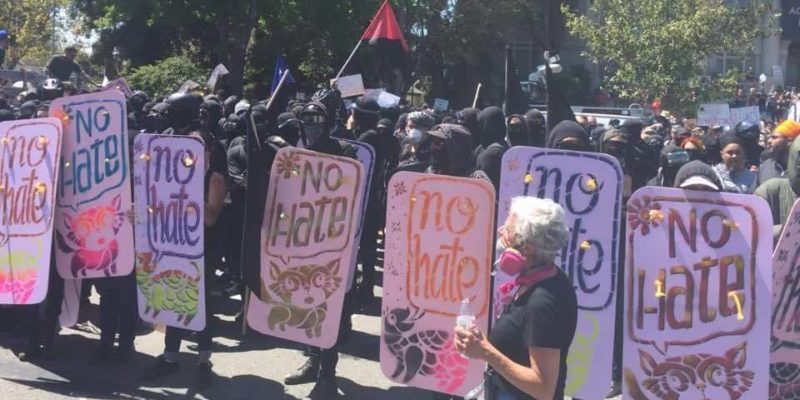Tag: nonviolence
Can you be Buddhist and antifa at the same time?
Haven’t processed all of this yet, but this is a great exploration of antifa from a Buddhist perspective. Please read if like me you are troubled by both violence and nazis.
On perceptions:
I also want to think about this on a “Buddhist” level. What do we expect Buddhists to look like at these demonstrations? Based on mainstream images, we might expect thin, glowy, non-disabled, ‘wise-seeming’ adherents, typically white, occasionally Black. (Thanks, racist erasure.) We might expect them to be sitting in meditation, legs crossed, face uncovered and untroubled. There is nothing wrong with any of these forms, but it’s a problem when our expectations calcify around them. This problem is not new. Chögyam Trungpa Rinpoche identified it in his classic book, Cutting Through Spiritual Materialism. If we’re not careful, we can slide into stereotypes and assumptions about how awakening behaves. What it wears. How it sounds. And that’s where ego creeps in, just when we think we’re being all awakened and marvelous.
On violence as a tactic:
…My commitments to transforming oppression lead me to seek relationship and solidarity with those actively opposing white supremacy.
That means I’m going to encounter plenty of people I disagree with. I’m not going to sit here and pretend that some people in Antifa, and some who use black bloc tactics, aren’t animated by rage and a desire for destruction. Even vengeance. But this scares me less, even on a moral level, than those who would pretend that the world’s seemingly endless stream of searing injustice doesn’t warrant our rage.
I am unarmed. I will remain unarmed. Buddhist Peace Fellowship will never promote attacking an enemy. But in my mind, this is a profoundly privileged position, almost an accident of luck, and a calling for which I am grateful — not a trophy of righteousness with which to bludgeon others who choose to engage in self defense.
…
Taking heed from spiritual-political revolutionary and writer adrienne maree brown, let’s be honest about whose bodies are at stake, and act accordingly. Violence surrounds us every day, all the time, inescapable. How do we bring about radical transformation (which necessitates destroying many current systems of greed, hatred, and delusion), while remaining as true as possible to a life of awakening and compassion?
Read more and join the conversation at The Buddhist Peace Fellowship website.
What is the point of direct action?
Why do those annoying protesters keep messing everything up with their inconvenient disobedience? My friend Deanna Zandt made a great explainer. Feel free to share.
Nonviolence is still a radical notion
 All of the comics in The Village Voice‘s “The 10 Most Subversive Comics at New York Comic Con” look great, but I most appreciated the shout out to John Lewis’ new book March (which I just read) as well as the Fellowship of Reconciliation‘s 1957 comic explaining nonviolent direct action.
All of the comics in The Village Voice‘s “The 10 Most Subversive Comics at New York Comic Con” look great, but I most appreciated the shout out to John Lewis’ new book March (which I just read) as well as the Fellowship of Reconciliation‘s 1957 comic explaining nonviolent direct action.
I originally discovered The Montgomery Story when I worked at FOR. I’m so glad they are reprinting it!
“The most subversive comic available at New York Comic Con is at the Top Shelf booth, a reprint of The Montgomery Story, a comic first published in 1957 and approved by Martin Luther King Jr., who saw the pre-published pages and made editorial changes. Most important is a section in the back called “How the Montgomery Method Works,” a blueprint for passive resistance. This comic has been translated into countless languages (a Top Shelf rep showed me Spanish, Arabic, and Farsi). It’s an instruction book for changing the world, and it continues to do so.”
“The universe is on the side of justice”
Here are some thoughts to get you warmed up for Monday, Martin Luther King Day.
King’s notion of nonviolence had six key principles. First, one can resist evil without resorting to violence. Second, nonviolence seeks to win the ‘‘friendship and understanding’’ of the opponent, not to humiliate him. Third, evil itself, not the people committing evil acts, should be opposed. Fourth, those committed to nonviolence must be willing to suffer without retaliation as suffering itself can be redemptive. Fifth, nonviolent resistance avoids ‘‘external physical violence’’ and ‘‘internal violence of spirit’’ as well: ‘‘The nonviolent resister not only refuses to shoot his opponent but he also refuses to hate him.” The resister should be motivated by love in the sense of the Greek word agape, which means ‘‘understanding,’’ or ‘‘redeeming good will for all men.” The sixth principle is that the nonviolent resister must have a ‘‘deep faith in the future,’’ stemming from the conviction that ‘‘the universe is on the side of justice/”
– King Encyclopedia: Nonviolence
And here’s a scan of Dr. King’s application to become a member of the Fellowship of Reconciliation:



